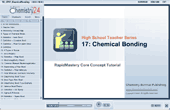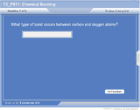Chemical Bonding
| Topic Review on "Title": |
Atoms bond chemically to form molecules.
Types of bonding
The periodic table is organized in columns, called groups or families, and rows, called periods. There are several groups or periods that have specific names.
| Bond type |
Happens between |
Electrons are |
Ionic |
Metal & non-metal |
Transferred |
Covalent |
Non-metals |
Shared |
Polar Covalent |
Non-metals |
Shared unevenly |
Metallic |
Metals |
pooled |
There are general characteristics of each type of bonding:
- Ionic: High melting points, most dissolve in water, conduct electricity when dissolved in water, brittle
- Covalent: Low melting points, most do not dissolve in water, do not conduct electricity when dissolved in water
- Polar covalent: Medium melting points, some dissolve in water, do not conduct electricity when dissolved in water
- Metallic: Soft, conduct heat and electricity, do not dissolve in water
Bond Polarity
When nonmetals bond covalently with a large difference in electronegativity, a polar bond is formed. A polar bond has a partial separation of charges. Polar bonds are symbolized with an arrow pointing towards the more electronegative element and a crossed tail by the less electronegative element
Valence Shell Bonding Theory
The Valence Shell Bonding Theory assumes that bonds are formed when atomic orbitals overlap. Direct overlap leads to sigma bonds and parallel overlap leads to pi bond.
|
| Rapid Study Kit for "Title": |
| Flash Movie |
Flash Game |
Flash Card |
| Core Concept Tutorial |
Problem Solving Drill |
Review Cheat Sheet |
 |
 |
 |
|
| "Title" Tutorial Summary : |
Atoms chemically bond together to form molecules. This tutorial introduces the types of bonds that occur, and the most simple bonding theory—Valence Bonding Theory.
|
| Tutorial Features: |
Specific Tutorial Features:
- Molecular animations of orbitals coming together to bond
Series Features:
- Concept map showing inter-connections of new concepts in this tutorial and those previously introduced.
- Definition slides introduce terms as they are needed.
- Visual representation of concepts
- Animated examples—worked out step by step
- A concise summary is given at the conclusion of the tutorial.
|
| "Title" Topic List: |
- Bonding
- Ionic
- Covalent
- Polar Covalent
- Metallic
- Valence Shell Bonding Theory
|
See all 24 lessons in college chemistry, including concept tutorials, problem drills and cheat sheets:
Learn Yourself to Teach Chemistry Visually in 24 Hours |



